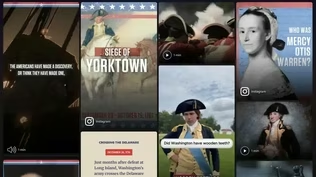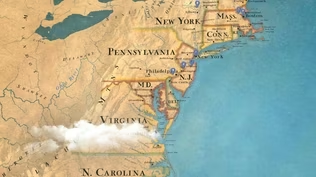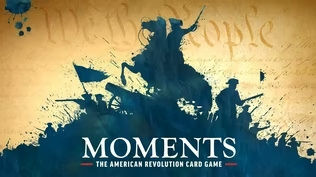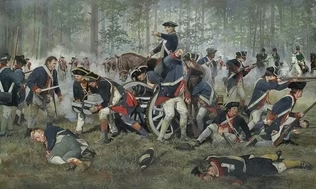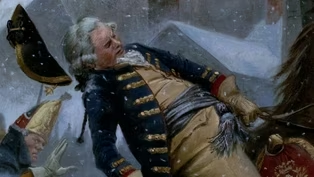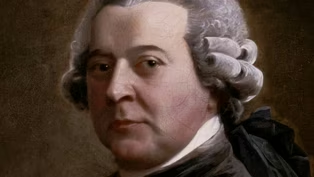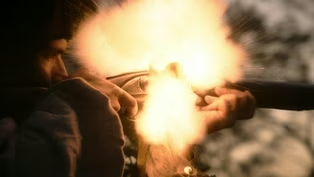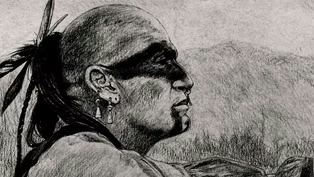
Warpath of Nations: The Naval Battle That Prevented a Canadian Invasion
Clip: Episode 3 | 5m 48sVideo has Closed Captions
Horatio Gates and Benedict Arnold rush to stop the British sailing down Lake Champlain.
After the defeat at Quebec City, a British invasion down the Hudson River seemed inevitable. Horatio Gates and Benedict Arnold are appointed to construct a navy to stop the British invasion on Lake Champlain. Despite being outnumbered two to one, Gates and Arnold are able to fend off the British force and halt the planned invasion until the following spring.
Problems playing video? | Closed Captioning Feedback
Problems playing video? | Closed Captioning Feedback
Episodes presented in 4K UHD on supported devices. Corporate funding for THE AMERICAN REVOLUTION was provided by Bank of America. Major funding was provided by The Better Angels Society and...

Warpath of Nations: The Naval Battle That Prevented a Canadian Invasion
Clip: Episode 3 | 5m 48sVideo has Closed Captions
After the defeat at Quebec City, a British invasion down the Hudson River seemed inevitable. Horatio Gates and Benedict Arnold are appointed to construct a navy to stop the British invasion on Lake Champlain. Despite being outnumbered two to one, Gates and Arnold are able to fend off the British force and halt the planned invasion until the following spring.
Problems playing video? | Closed Captioning Feedback
How to Watch The American Revolution
The American Revolution is available to stream on pbs.org and the free PBS App, available on iPhone, Apple TV, Android TV, Android smartphones, Amazon Fire TV, Amazon Fire Tablet, Roku, Samsung Smart TV, and Vizio.

MOMENTS: The Revolutionary War Card Game
Use your knowledge of Revolutionary-era moments to build a timeline of real historical events.Providing Support for PBS.org
Learn Moreabout PBS online sponsorship♪ After the American retreat from Quebec City in early 1776, a British drive down the Hudson seemed inevitable.
Before British General Guy Carleton's army could even reach the Hudson, he had to sail south and seize the two American forts at Crown Point and Ticonderoga, and before he could do that, he had to put together a fleet at the lake's northern end.
That had taken months.
Calloway: This water route is a corridor.
It's been called the Warpath of Nations, where Indian warriors from Canada had raided down the Champlain Valley, down the Hudson River, and so this was-- this was like an open door.
Narrator: The Americans had just 4 ships with which to oppose the British fleet.
Many more were needed.
Ticonderoga's commander, a former British major named Horatio Gates, appointed his most enterprising officer to get the job done.
Benedict Arnold was still limping from the wound he'd received at Quebec and was still angry at having been accused of stealing supplies during the retreat from Montreal.
Gates had dismissed Arnold's detractors.
"Men of little merit are ever jealous of those who have a great deal."
Voice: The enemy will soon have a considerable naval force.
I make no doubt of their soon paying us a visit.
I beg that at least 100 good seamen may be sent to me as soon as possible.
Benedict Arnold.
Narrator: Arnold transformed the tiny settlement of Skenesborough, 20 miles below Ticonderoga, into a bustling shipyard.
He had hoped for a fleet of at least 30 vessels but had to settle for just 15.
Voice: I intend to come up as high as Isle Valcour, where is a good harbor and where we shall have the advantage of attacking the enemy in the open lake.
[Arnold] Narrator: When the British flotilla finally started south on Lake Champlain, Carleton commanded nearly twice as many vessels as Arnold did, armed with more than twice as many guns, manned by 700 seasoned crewmen, and carrying 10,000 British and German troops and 400 Native allies.
Arnold and his fleet were waiting for them in a cove hidden behind Valcour Island.
[Cannonfire] As Carleton's fleet slid past, 4 American ships moved out onto the lake to engage the British, Arnold personally directing the guns of his flagship-- the "Congress."
[Gunfire] By evening, the fleets had fought to a standoff.
The Americans had lost 2 vessels but succeeded in blowing up a British gunboat.
As darkness fell, Carleton ordered his fleet to keep the Americans trapped so that he could destroy them the following day... ♪ but at 7:00, while fog covered the lake and Carleton and his officers were dining below deck, Arnold formed his battered ships into a single line and then ordered them with muffled oars and in complete silence to glide slowly past the British squadron.
[Gunfire] When Carleton finally caught up with them, they began a running battle that went on for 2 days.
British firepower took a steady toll.
Arnold eventually ordered his flagship and 4 other vessels run aground in Button Mould Bay and set on fire.
He and his men escaped into the forest.
When they reached Crown Point, Arnold realized the fortifications there could not withstand a serious British attack and ordered them burned to the ground.
[Flames crackling] "At 4:00 [in the] morning, I reached [Ticonderoga]," Arnold recalled, "exceedingly fatigued and unwell, having been without sleep or refreshment for near 3 days."
Voice: It has pleased Providence to preserve General Arnold.
Few men ever met with so many hairbreadth escapes in so short a space of time.
Horatio Gates.
Philbrick: The battle was not a victory for the Americans, but it is one of the great slugfests of naval warfare, and it happens on a lake.
It convinced the British that it was gonna be much more difficult to take Ticonderoga than they thought.
Narrator: The American force at Ticonderoga had grown to 15,000, and its fortifications had been strengthened.
Carleton now believed a long siege would be needed to take it.
Then it began to snow.
Once the lake froze, provisioning his forces would be difficult, and a retreat would be impossible.
Carleton turned around and withdrew, eventually going into winter quarters at Quebec City far to the north.
The British began to plan a second, more significant invasion for the next spring.
The Battle of Long Island (Brooklyn)
Video has Closed Captions
Clip: Ep3 | 6m 10s | General Clinton ambushes George Washington in the largest battle of the American Revolution. (6m 10s)
Video has Closed Captions
Clip: Ep3 | 6m 44s | Washington devises a bold plan to cross the Delaware River and attack Trenton on Christmas night. (6m 44s)
Democracy & The Adoption of the Articles of Confederation
Video has Closed Captions
Clip: Ep3 | 6m 14s | The Continental Congress meets to debate and adopt the Articles of Confederation. (6m 14s)
Preview: The Times That Try Men’s Souls
Video has Closed Captions
Preview: Ep3 | 30s | Washington abandons New York City and flees across New Jersey, before attacking Trenton. (30s)
Tsi'yu-gunsini and the American Revolution on the Frontier
Video has Closed Captions
Clip: Ep3 | 5m 50s | Cherokee chief Tsi'yu-gunsini, Dragging Canoe in English, fights against Patriot settlers. (5m 50s)
Video has Closed Captions
Clip: Ep3 | 5m 24s | The British assault Breed's Hill and Bunker Hill near Boston in the bloodiest battle of the war. (5m 24s)
Providing Support for PBS.org
Learn Moreabout PBS online sponsorshipSupport for PBS provided by:
Episodes presented in 4K UHD on supported devices. Corporate funding for THE AMERICAN REVOLUTION was provided by Bank of America. Major funding was provided by The Better Angels Society and...

